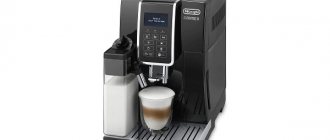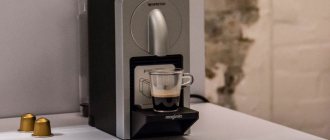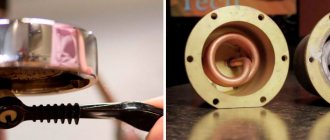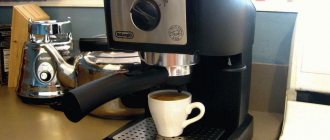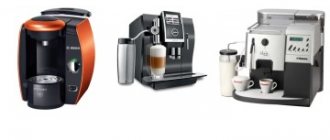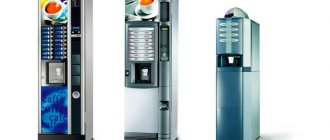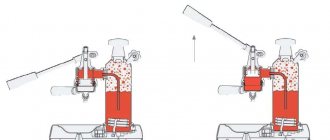How and from what does scale form?
We do not use sterile water for preparing food and drinks. Even filtered or bottled water contains a certain set of minerals. These include calcium, magnesium, iron. When water is heated, some of these minerals form an insoluble precipitate that remains at the points of contact between the heating elements and the water. Over time, sediment accumulates, the layers harden and form a crust. It's called scale. The more impurities in the water, the faster scale forms.
Scale can form in a coffee machine even from filtered or bottled water. The harder the water, the faster scale forms.
When cleaning is necessary
There are no special factors that could prompt cleaning. The barista must independently monitor the quality of his machine. The following can be taken into account:
- When you normally pass water through a machine, sediment forms at the bottom of the glass.
- The spill is not working correctly - the filter and the tubes are clogged, this is the first call.
- Unpleasant taste of drinks.
Scale can form in a coffee machine even from filtered or bottled water. The harder the water, the faster scale forms.
It all depends on the popularity of the establishment. As practice has shown, coffee shops clean on average 1-2 times a week.
Decalcification is the removal of mineral plaque by softening the calcium crust. It is impossible to scrape off plaque by mechanical means.
What is decalcification of a coffee machine?
The basic element of scale is calcium salts. They have a loose, porous structure and easily add other elements from the water: iron, magnesium, potassium, fluorine. Decalcification is the removal of mineral plaque by softening the calcium crust. It is impossible to scrape off plaque by mechanical means. Rough intervention is dangerous as it can damage the heating elements of the coffee machine.
Therefore, decalcification is carried out using special means that react chemically with calcium salts. As a result, the crust softens, crumbles and is easily removed with water. Modern industry produces ready-made products to combat plaque. Some coffee machine owners prefer traditional, low-cost life hacks that help deal with this problem.
Why is decalcification necessary or why is scale dangerous?
Limescale in a coffee machine is dangerous both for equipment and for humans. Deposits cause problems with the heating element. In a coffee machine it is very small, so even minor interference will interfere with its effectiveness. The scale forms a kind of coupling around the heating element, interfering with heat transfer. The result is a double negative effect.
- The heating element overheats and can burn out from excess heat
- The coffee water is not hot enough.
Insufficiently heated water does not do a good job of brewing coffee; the drink turns out sour, weak and cloudy due to underextraction.
Repair shops will tell you cases where not only heating elements, but also the entire body of the coffee machine suffered due to limescale deposits. Over time, lime corrodes fastening and connecting elements.
How else is scale dangerous?
- Blockage of the water passage in the system.
- Blocking the tap through which coffee flows into the cup.
- Getting into a cup of coffee.
- The proliferation of bacteria that thrive in the loose structure of limescale.
Decalcification extends the life of the coffee machine and allows you to prepare tasty and safe coffee.
Alternative remedy
You can fight scale and plaque not only with commercial detergents. Do-it-yourself care is always better than no care at all. Citric acid will help get rid of coffee deposits and sediment. It needs to be diluted with water in a ratio of 1 to 3. Usually, no more than 3-4 tablespoons of powder are added per liter of water. After filling the water tank, pass the liquid through the system by pressing the drink preparation button.
Coffee machine tablets
Citric acid cannot completely remove scale, especially limescale with an impressive layer of the substance. The manufacturer does not recommend using vinegar as a household aid. Acid can corrode internal parts of the device and weaken seals. This negatively affects the functioning of the coffee machine. High-quality cleaning is ensured by comprehensive care products for Philips devices.
Coffee break
When should decalcification be carried out?
The timing of the decalcification procedure is indicated in the instructions for the coffee machine. Automatic coffee makers can themselves report the need for a procedure. You should not think that the machine evaluates the state of the water and its elements. It is programmed to decalcify after a certain number of cups of coffee are prepared. All machines are designed for use with hard water.
If your machine is not equipped with reminder functions, and the instructions do not contain anything about decalcification periods, then rely on the following recommendations from service specialists.
- If you only use bottled water, you can decalcify once every 10-12 months.
- If you use filtered water, then decalcification should be done every 6-8 months.
- If your area has hard water and you use a filter, then decalcification should be done after 4-6 months.
- If your area has hard water and you do not use a filter, then decalcification should be carried out every 3-4 months.
Indirect signs of the need for decalcification may include:
- musty smell of coffee;
- increased machine noise;
- foreign impurities in coffee.
Why is decalcification needed?
As a rule, plaque inside the structure of the coffee machine occurs due to the quality of the water used during operation. Agree, few of us use distilled water to make a cup of coffee. If you use tap or poorly filtered water, a hard, dense coating of salts and even corrosion will soon form. This will affect the performance of the device and the taste of the drink. Then the question arises, how to descale a coffee machine, and what decalcification products are best to purchase.
How do you know when it's time to descale?
- The coffee was no longer rich and aromatic, and a bitter taste appeared.
- The cooking process has become slower.
- The steam pressure has decreased.
- The drink began to flow in a thin stream, and the pressure decreased.
- There was a loud noise while the coffee machine was operating.
If you notice such signs, it means that the device needs urgent decalcification. Now you need to choose a suitable cleaning agent for the coffee machine and figure out how to rinse the device to remove scale and increase its service life.
Coffee machine decalcifiers
There are many means for decalcifying a coffee machine, which can be divided into specialized and popular ones.
Specialized decalcification products
Specialized preparations for decalcification are produced in the form of liquid and tablets.
Liquids are sold in bottles for 1-2 uses. Many manufacturers of coffee equipment prescribe in their instructions the use of only branded products of the corresponding brand: Bosch or Saeco.
There are multi-brand liquids for universal use, for example, Top House or Filtero.
The compositions of all products use the same active substances, so it is quite possible to use any universal product for decalcification.
Tablet preparations differ in the form of release and the concentration of active substances. One or two tablets are usually enough to clean the coffee machine. Tablet products are cheaper than liquid ones.
Folk remedies for cleaning coffee machines
These include citric acid. An acidic environment softens calcium deposits well. The acid is diluted at the rate of 10 g per 1 liter of water and the resulting solution is used.
Citric acid is inferior in effectiveness to specialized products. Some experts consider it too aggressive for the heating element and the body of the coffee machine. The use of citric acid can damage the protective coating of heating elements and they will begin to rust.
No other types of acids can be used for decalcification, not even the popular acetic or oxalic acids. They are too aggressive for the internal structure of the coffee machine.
Descaling products
The coffee machine can be descaled using the following methods:
- Manual cleaning of internal parts from accumulated plaque and deposits.
- Easy rinsing with water after each coffee brewing cycle. This option is suitable for some geyser coffee makers - for example, DeLongy and Krups, as well as for cleaning a Bosch drip-type coffee machine.
- Folk remedies - for example, citric acid.
- Manufacturers of modern models offer special tablets for cleaning coffee machines.
- In particularly advanced cases - professional cleaning at a service center. By the way, specialists can give you valuable recommendations on how to clean your coffee machine correctly.
How to descale a coffee machine?
Automatic coffee machines in the high price segment have special cleaning programs. You need to pour liquid descaling agent into the machine and run it in the desired program. If you are using tablets, the drug must be diluted in water according to the instructions and, after complete dissolution, the tablets must be used in the same way as a liquid product.
In some models, a special program is not provided and cleaning is performed in a sequence of actions. The entire procedure is described in the instructions for the coffee machine.
Semi-automatic and many automatic coffee makers are cleaned by simply running the coffee program. Do not add grains; instead of water, add cleaning liquid or a tablet diluted in water. The resulting “drink” is immediately poured out and the procedure is repeated with plain clean water, without any means.
The decalcification procedure is always described in the instructions for the coffee machine. Therefore, strictly adhere to the sequence of actions. The only place where deviation is appropriate is the choice of means. You can take a generic one rather than a branded one, or replace the liquid with tablets.
How is manual cleaning done?
In any case, the owner of a professional machine must regularly clean the equipment manually. It is recommended to come to this procedure at least once a month. How to properly descale a delonghi coffee machine:
- Machine instructions - describes in detail which parts can be removed and which parts cannot be touched.
- Allow time to clean and assemble the machine.
The compositions of all products use the same active substances, so it is quite possible to use any universal product for decalcification.
The process itself will not take much time:
- The filter and containers are removed and treated to remove any remaining grounds.
- If you use gel, it should be poured into a water container. Many of them are concentrated and require dilution with water.
- Using the correct heating temperature also depends on the cleaning product used.
- Next comes the drain. Usually – 250 ml.
If your area has hard water and you do not use a filter, then decalcification should be carried out every 3-4 months.
Important! It is advisable to do the spilling in small doses, every 5 minutes.
The tablet's action process is similar. Each piece is dissolved in water in advance, after which the usual spill is performed.
Automatic coffee makers can themselves report the need for a procedure.
How much does decalcification and refusal cost?
The most painful issue is financial. Many people think that decalcification is too expensive. Let's do the math.
- 800-1200 rubles for a bottle of branded cleaning liquid. It is enough for 1-2 uses.
- 150 to 500 rubles per bottle of a universal product.
- 200-450 rubles per pack of tablets, one tablet – one cleaning cycle.
We find that the cost of a cleaning “session” ranges from 50 to 600 rubles.
How much does it cost to not descale your coffee machine?
A burnt heating element will lead to replacement of the boiler, and this costs from 8-10 thousand without transportation costs.
Auto cleaning
Timely implementation of the coffee machine decalcification process will ensure the high quality of the prepared drink with exquisite taste characteristics.
All capsule-type devices are equipped with an automatic cleaning system. When the corresponding sensor is triggered, the coffee machine is blocked, preventing it from being used until the descaling program has been started.
The entire decalcification process consists of filling the device reservoir with a special solution (based on a decalcifier) and then starting the cleaning program. This takes 15-20 minutes depending on the type of coffee machine. At the end of the process, you need to rinse the device several times and run the “drink brewing” program (without adding coffee).
It is not recommended to drink the first few cups of coffee prepared after the cleansing procedure.
